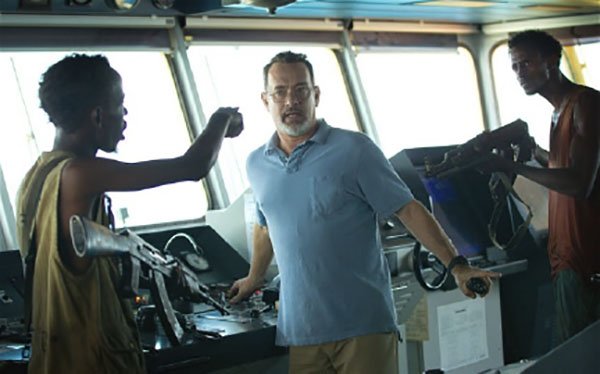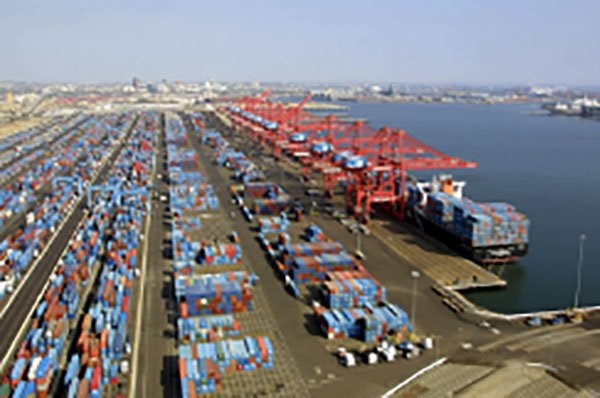No Monster Warehouses
Many saw the action thriller “Captain Phillips,” about the Somali pirates, who attempted to take control of the container ship, the Maersk Alabama. Tom Hanks gave a great performance. What I would like you all to do is think about this story not as a great nail-biting, gut-wrenching tension-packed tale of resistance to outlaws, but as a metaphor about globalization, about what happens when the paths of the very poor and the very rich intersect in the crossfire of world economics.
In 2010, the Harvard Business School chose Somali pirates as the best-business model of the year, during which 544 seafarers were captured for ransom in the first half of the year alone. The African Development Bank reported this in 2011, stating, “When the regime of longtime Somali dictator Siad Barre collapsed in 1991, the country was plunged into ongoing violence between rival armed groups and left the country without a central government capable of defending the country’s economic interests—including the “exclusive economic zone” (EEZ) off the Somali coast. Fleets from Europe and Asia quickly moved in, depleting the supply of fish. Fishermen, dismayed at the number of foreign fishing vessels illegally exploiting their traditional fisheries, took matters into their own hands. Initially arming themselves to chase off the illegal foreign fishing vessels, they quickly realized that robbing the vessels was a lucrative way to make up for lost income.” This is a lot like what is happening around the world to traditional jobs, except that the workers have not resorted to piracy yet.
A container ship and tugboats in Hong Kong’s Victoria Harbor
The global economy has created a new reality. The goods of the world are moved by container ships from low wage factories to distribution centers around the world. This process of distribution begins with piling enormous containers often stacked over five stories high onto ships that are registered under a multitude of different flags. As has been pointed out in recent books and articles on the subject, these shipping companies “are among the most definitely opaque businesses in the world. They are masked by a system of flags of convenience, under which ships are registered in countries other than their owners’, allowing them to skirt fees, taxes, and labor regulations.”
Port of Los Angeles/Long Beach, the Hanjin Terminal
The goods from these low wage jobs, from cell phones and sneakers to consumer products like toothpaste, enter the United States from gigantic container ports like Los Angeles/Long Beach, or Elizabeth, New Jersey. The containers are then loaded onto railroads or shipped by tractor-trailer trucks to huge distribution centers across the country.
Port Elizabeth, New Jersey, Container Terminal
These enormous distribution centers are located all over the country. In California, there are many examples like Target’s warehouse in Fontana, California, where the warehouse sits amid a residential development; the Amazon behemoth in the City of Patterson near Tracy; and the recently completed Skechers footwear retailer’s 1.82 million square foot facility, a fully automated distribution center, in Moreno Valley.
I can’t praise these buildings as I feel they are incredibly ugly and a blight upon the landscape. Many of the developers claim their facilities are “green” buildings, and some have been awarded LEED certification for their energy conservation measures. In my thinking this is a violation of the essential concepts behind sustainable design.
Target Distribution Center, Fontana, CA
Amazon Distribution Center, City of Patterson, CA
Skechers USA’s 1.82 million sq. ft. distribution center in California’s Moreno Valley
Another example of the warehouse proliferation and its associated environmental and employment issues is on the East Coast. Carlisle, Pennsylvania, because of its location at the crossroads of east-west and north-south interstate highways has become one of the most heavily utilized locations for the construction of million-square-foot warehouses from which goods arrive from the Los Angeles/Long Beach port and the Port Elizabeth port via container hauling trucks where they are re-distributed to the retail business like Wal-Mart, Target, Unilever, and CVS. Here Prologis, the enormous global real estate development company, constructed several of these million-square-foot warehouses, which it sublets to other consumer product corporations; and Amazon established a gigantic warehouse for the redistribution of its books and other products.
Prologis Warehouse in Carlisle, Pennsylvania 2013
In Carlisle these huge logistics distribution centers have replaced the old jobs in factories, where Americans could find skilled employment that allowed them to realize the American dream of a home of one’s own, a car, perhaps even a boat, and higher education for the kids The factories closed as globalization moved jobs from the Rust Belt of the northeast to Mexico, China, and Southeast Asia, Carlisle was the home of the Masland Carpet factory, the Carlisle Corporation, once a tire factory, now maker of singly-ply roofing, and AMP Incorporated, where those snap-in plugs at the back of our computers and the phones that we all used to use for our land lines were made. Most of the facilities have been demolished. In the case of AMP, the company was stripped of its assets by the corporate raider, Dennis Kozlowski, CEO of Tyco International, who was subsequently convicted of misappropriation of funds and sentenced to 8 to 25 years in Prison. In 2014 Kozlowski was released from prison serving only 8 years.
Interior of a large distribution warehouse
The low wage workers that are employed in these high bay facilities in Carlisle running the forklifts and pallet jacks refer to these places as jails. Pennsylvania is a “right to work” state, which restricts union enrollment. In the facilities there are no windows and few amenities for workers. If a worker is injured on the job, the company will resist assisting. A worker while driving a forklift got something in his eye. He was not allowed to go to a doctor for four hours. Then the company demanded he be tested for drugs and alcohol. He passed the test. When the doctor finally saw the employee, he stated that the delay in help caused more damage to his eye. The employee sued.
One worker I interviewed spoke about the lack of rights the workers had in this new global economy. They receive no health benefits and are docked points for various infractions of company rules. An employee who accumulates eight points is fired. Points are given for being late or leaving early. A quarter-point is assessed for being 1 to 15 minutes late. From 16 minutes to two hours late the penalty is half point. For leaving early, even for a doctor’ s appointment, the charge is a half point. Employees are allowed four general-purpose days off a year, which must be scheduled three days in advance. Taking an unscheduled day off, say if a child is sick, costs a point. Employees can be required to work five twelve-hour days in a row without accruing additional vacation days. The company my contact worked for also had a quota system for goods moved. Failure to meet this quota results in firing.
Interior High Bay Distribution Warehouse
One warehouse had 283 employees in three shifts. In six months, there were 293 employee turnovers. My contact was fired for exceeding the point total. This erosion of employee rights is the new reality of employment in America. There are no prospects for long-term employment. There are few opportunities for advancement. According to the Economist magazine, these warehouses are leading candidates for robotization. Programmable robots will in the next decade replace even these low wage jobs of moving goods from trailer to warehouse and warehouse to trucks. Amazon is leading this trend and is even experimenting with using drones to deliver their products.
An Amazon Distribution Center in Phoenix, Arizona.
In Carlisle, Pennsylvania, where there are currently millions of square feet of unused warehouse space, developer Goodman Birtcher proposed a new 2.8-million-square-foot warehouse. They and local business interests stated in the zoning hearing that the warehouse will bring at least 1,000 new jobs and will increase regional tax revenue. Given the reality of low-wage hourly employment and the impending robotization of work in these logistic faculties, I find their employment argument specious.
Two of hundreds of posters against the Monster Warehouse along Route 11 outside Carlisle, Pennsylvania.
The developer wants to take more farmland and convert it to an enormous tilt-up windowless walled structure. This in a county of rich farmland, which was called the breadbasket of the American Revolution, because this area of central Pennsylvania provided the food for George Washington’s Army in its battle with the British. Opposition to this warehouse is very vocal and substantial. Many residents of the four townships, Carlisle, South Middleton, West Pennsboro, and Dickinson, are completely opposed based on the loss of productive farmland, the increased truck traffic on local roads, the damage to the rural environment, the light pollution from the 24-hour area lamps, and the decrease in property values that follow the construction of these mega-warehouses. Hundreds of signs stating, “No Monster Warehouses,” are displayed throughout the area.
Despite the Dickinson Township’s planning department’s opposition to the warehouse, which is mainly located in this township, the township supervisors voted to permit Goodman Birtcher’s development. In a separate action, the mayor of Carlisle sided with the developers by casting the tie-breaking vote in the closely contested battle over access to the site from Borough of Carlisle. He stated he had voted yes to the development because he said he wanted Carlisle to have a seat at the table when the warehouse was constructed. Local opposition has vowed to continue the fight against this project and has sued. However, given the deep pockets of the business backer, the lawsuit will probably fail, and another ugly building will degrade the beautiful landscape and the mainly rural environment of Cumberland County, Pennsylvania.
Eight years have passed since the protests took place against the increasing number of monster warehouse. Now it appears that the opposition has given up. More warehouses have been built and more farmland in this rich agricultural area, the breadbasket of the American revolution, has been plowed under.











